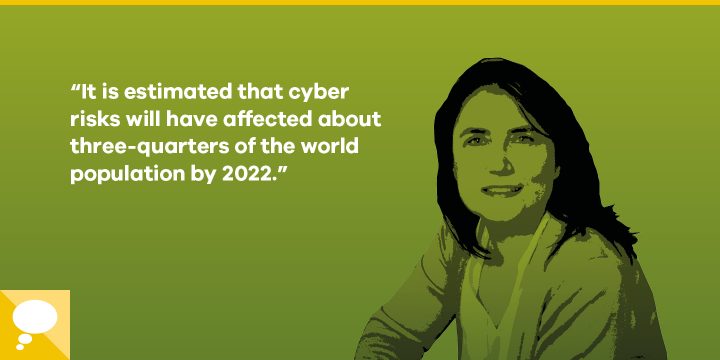
There is a famous motto in the business world, “You can manage what you can measure”; however, remember that you can measure only those that you can understand.
Bikem Kanık
Paribu Advisory Board Member
All sectors and all businesses have only four different options to handle risks. Above all, you should detect and measure the risks your enterprise is to face.
- First, if the measured risk is too big to take, you avoid it. That is, you do not take the risk.
- Secondly, if you believe that your gain matters more no matter how big the risk is, then you accept the risk, live with it, and hope that it does not become real. That is, you do nothing.
- Third, you regularly monitor the risk, define procedures to manage it, and try to mitigate its impact. That is, you carry out risk management.
- Finally, you transfer the risk. That is, you buy an insurance policy.
The best practice is to adopt the last two options together. You should manage your risk, mitigate it as much as possible, and transfer the rest using insurance instruments.
Insurance helps take the risk away from corporations and relevant individuals, and it enables you to focus on what really matters to conduct and grow your business.
Blockchain and digital assets
According to IDC, a technology market intelligence firm, global blockchain expenditures in the financial sector alone reached $2.9 billion in 2019 and total global blockchain expenditures are estimated to reach $12.4 billion by 2022. It comes as no surprise that investments increase rapidly and consistently.
Blockchain technology and digital assets offer an incredible potential in designing groundbreaking business models and in cybersecurity, privacy, control of secret data as well as better management of other critical challenges. However, since these associated technologies are relatively new and grow rapidly, companies using such technologies encounter a complex environment and progressive regulations. In addition, the current insurance schemes of businesses may not have taken into account the risks that may arise out of P2P (peer-to-peer) data exchange and data processing in blockchain.
If blockchain deals with cross-border fund transfers, it may be necessary to become familiar with Know Your Customer (KYC) procedures and Anti-Money Laundering (AML) regulations. The corporate risks of blockchain should be identified early and managed throughout the life cycle of the system.
Another interesting point is that contrary to the biases of regulatory authorities in the markets, the rate of illegal transactions is reduced as cryptocurrencies are more widely used and their areas of use become more diverse. According to Chainalysis, out of all cryptocurrency transactions carried out in 2019, which exceeded an amount of 1 trillion dollars, only 1.1% of transactions were illegal.
Insurance of digital assets
As the recognition, acceptance, and popularity of digital assets increase, the ecosystem supporting these new assets and their owners also grows. Roughly speaking, this ecosystem consists of cryptocurrency exchange markets, deposits, issuers, wallets. and miners. This growing ecosystem has resulted in a significant increase in the risks which require an innovative risk transfer solution (insurance).
The security of digital assets is one of the fundamental concerns of those who own digital currencies. In the cryptocurrency world, there is a concept called cold storage. In a nutshell, this concept means the storage of cryptocurrencies in a medium contained other than the Internet. In short, it means “offline” wallet. In other words, you have a digital wallet and this wallet has no connection to the Internet by any means. As it is “offline”, it cannot be hacked or stolen.
Designed for digital assets, Cold Storage Insurance coverage ensures protection against loss of digital assets due to internal and external theft, damage to digital keys, or destruction of special keys. In fact, this is a brand-new insurance policy for the markets. Although it has not still reached a widespread network in the world, it is one of the most rapidly developing products in the market.
Cyber Risk Insurance offers coverage for regulatory liability associated with first-party losses (including costs arising out of business interruption and a notice of breach), third-party liability and network security, data privacy and system failure.
It is estimated that cyber risks will have affected 6 billion Internet users, that is about three-quarters of the world population by 2022. In 2021, damages caused by cybercrimes may reach up to $6 trillion, which would be equal to the gross national product of the third-largest economy in the world.
Covid-19 and cybersecurity
“Perhaps it is better at this point to imagine a world with Covid-19, rather than a world after it. We cannot go back to the world of 2019.”
Niall Ferguson (Economic Historian)
Millions of people around the world are currently working remotely. Security and IT teams are exposed to new and ever-increasing demands as well as increased psychological stress. In this period, the activities of ill-intentioned actors in the market have globally intensified. Some temporary solutions applied in this period naturally made it necessary to bypass the stages of development, approval and release, which are normally applied in the existing cybersecurity policies.
Corporations should review and revisit their technological infrastructure as well as cybersecurity measures while they implement social distancing directives and business processes and deal with new economic realities that are a result of the pandemic.
Bu içerik en son 26 October 2022 tarihinde güncellenmiştir.
